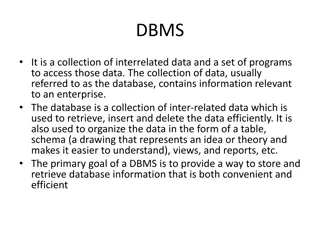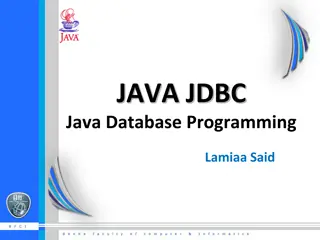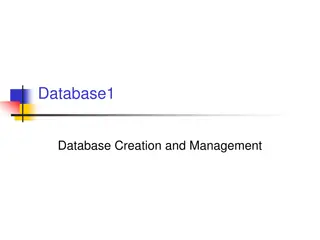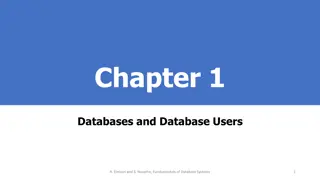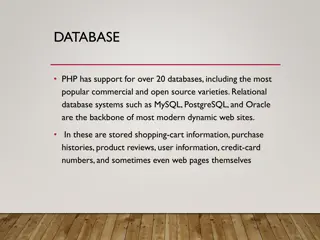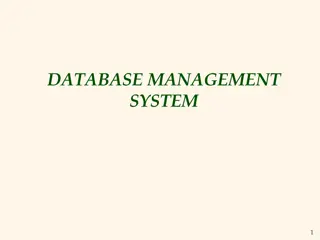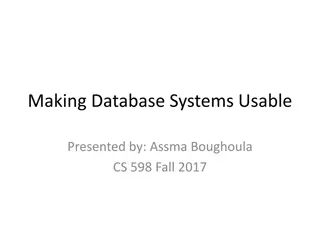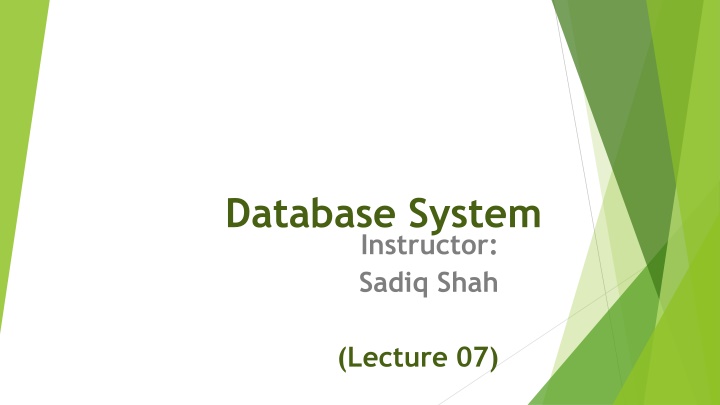
Logical Database Design and Relational Model Overview
Explore the basics of logical database design and the relational model, including components like data structure, manipulation, and integrity. Learn about relational keys, primary keys, composite keys, and foreign keys in database systems.
Download Presentation

Please find below an Image/Link to download the presentation.
The content on the website is provided AS IS for your information and personal use only. It may not be sold, licensed, or shared on other websites without obtaining consent from the author. If you encounter any issues during the download, it is possible that the publisher has removed the file from their server.
You are allowed to download the files provided on this website for personal or commercial use, subject to the condition that they are used lawfully. All files are the property of their respective owners.
The content on the website is provided AS IS for your information and personal use only. It may not be sold, licensed, or shared on other websites without obtaining consent from the author.
E N D
Presentation Transcript
Database System Instructor: Sadiq Shah (Lecture 07)
Logical Database Design and the Relational Model
Basic Definitions The relational data model represents data in the form of tables. The relational data model consists of the following three components (Fleming and von Halle, 1989): 1. Data structure Data are organized in the form of tables, with rows and columns. 2. Data manipulation Powerful operations (typically implemented using the SQL language) are used to manipulate data stored in the relations. 3. Data integrity The model includes mechanisms to specify business rules that maintain the integrity of data when they are manipulated.
RELATIONAL DATA STRUCTURE Relation: A named two-dimensional table of data. Each relation (or table) consists of a set of named columns and an arbitrary number of unnamed rows. An attribute, consistent with its definition in Chapter 2, is a named column of a relation. Each row of a relation corresponds to a record that contains data (attribute) values for a single entity.
This relation contains the following attributes describing employees: EmpID, Name, DeptName, and Salary EMPLOYEE1(EmpID, Name, DeptName, Salary) RELATIONAL KEYS Every relation must have a primary key. A primary key is an attribute or a combination of attributes that uniquely identifies each row in a relation. We designate a primary key by underlining the attribute name(s). For example, the primary key for the relation EMPLOYEE1 is EmpID. Notice that this attribute is underlined in Figure
Primary key An attribute or a combination of attributes that uniquely identifies each row in a relation. EMPLOYEE1(EmpID, Name, DeptName, Salary) Here EmpID is a primary key The concept of a primary key is related to the term identifier. The attribute or a collection of attributes indicated as an entity s identifier in an E-R diagram may be the same attributes that comprise the primary key for the relation representing that entity.
Composite key A primary key that consists of more than one attribute. E.g C.No and Department Name in this class STUDENT(C.No, DeptName, StudentName) STUDENT(C.No, Semester, Deptmame, )
Foreign key An attribute in a relation that serves as the primary key of another relation in the same database. Often we must represent the relationship between two tables or relations. This is accomplished through the use of foreign keys. A foreign key is an attribute (possibly composite) in a relation that serves as the primary key of another relation. For example, consider the relations EMPLOYEE1 and DEPARTMENT: EMPLOYEE1(EmpID, Name, DeptName, Salary) DEPARTMENT(DeptName, Location, Fax) The attribute DeptName is a foreign key in EMPLOYEE1. it Is represented as dashed lines:
PROPERTIES OF RELATIONS We have defined relations as two-dimensional tables of data. However, not all tables are relations. Relations have several properties that distinguish them from non-relational tables. We summarize these properties next: 1. Each relation (or table) in a database has a unique name. 2. An entry at the intersection of each row and column is atomic (or single valued). There can be only one value associated with each attribute on a specific row of a table; no multivalued attributes are allowed in a relation. 3. Each row is unique; no two rows in a relation can be identical. 4. Each attribute (or column) within a table has a unique name. 5. The sequence of columns (left to right) is insignificant. The order of the columns in a relation can be changed without changing the meaning or use of the relation. 6. The sequence of rows (top to bottom) is insignificant. As with columns, the order of the rows of a relation may be changed or stored in any sequence.
Pine Valley Furniture Company The four relations shown in this figure are CUSTOMER, ORDER, ORDER LINE, and PRODUCT



